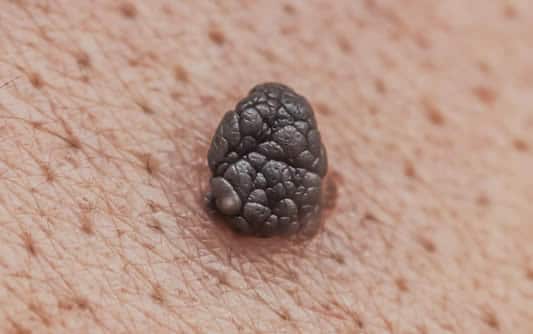The phrase “skin lesion” covers a wide range of color changes, lumps and bumps, patches, rashes, and other things on or under the skin. Freckles, moles, areas of itchy, dry skin, and many other marks all qualify as skin lesions. Many are normal, but a few can be deadly.
1. Not all the brown spots on your skin are moles.
- Moles are collections of melanocytes—a type of pigment-producing cell. They can be flat or elevated, brown, black, or pink, and they often appear early in life. Moles generally stop appearing after age 40. Over time, they have the potential to develop into skin cancer.
- But not all dark spots on your skin are moles. They can also be harmless freckles or sun spots—which are flat spots that occur in sun-exposed areas due to UV exposure. Brown spots that occur after age 40 are often seborrheic keratosis, also known as wisdom or age spots. They are elevated brown bumps that can have a waxy or crusty texture. Though their appearance may be concerning, they are not made up of melanocytes, so they do not carry a risk of skin cancer.
2. Scar tissue can also appear as a brown spot or bump on the skin.
A dermatofibroma is a flat or slightly elevated bump with a white to purple scar tissue center surrounded by a brown rim. Dermatofibromas are benign.
3. Rashes are skin lesions, too. And the most common rash culprit may surprise you.
A rash is composed of skin lesions that may cover a small or large area of skin. Rashes can happen for lots of reasons, but one of the most common causes is a reaction to personal care products like creams, lotions, soaps, and shampoos. The fragrances and other substances in these products can often irritate the skin, Fiessinger said. Clothing-related products like detergents and fabric softeners also fall into this category. Even though these products are not applied directly to the skin, the chemicals contained in them can linger in the clothing that you wear.
If you think a personal care product may be causing a rash, Fiessinger recommends switching from your current product to a gentler, fragrance-free version. People can develop sensitivities to products at any time, even if you have been using the same product for years without experiencing any negative effects. In addition, companies are always changing ingredients and formulations of their products, so there may be a new substance in your go-to product that you’re reacting to.
If you switch products and the rash doesn’t go away, then it’s time to visit a dermatologist to determine the cause.
4. How often should you get a skin exam? It depends.
There aren’t one-size-fits-all guidelines for when people should follow up with a dermatologist. In general, it’s smart to go in for an appointment any time you see something on your skin that concerns you. At that initial appointment, the dermatologist will talk with you about your family history and assess your skin cancer risk. This will help your doctor determine when you should come back for your next screening appointment. There’s no substitute for a dermatologist’s trained eye, and catching problems early can make all the difference.

